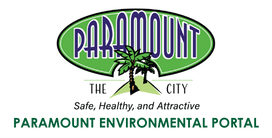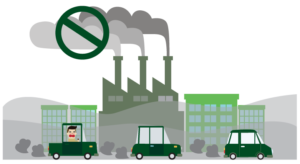Air Quality FAQs
You can find the latest air-related information and news, including a link to the latest Air Monitor Map, on the Air webpage of the Paramount Environment website.
In 2016, the City of Paramount learned that extremely high levels of a toxic metal, hexavalent chromium (CR6+), had been detected in the city’s air. While the South Coast Air Quality Management Division (AQMD) was the agency that detected the CR6+ concentration and also had the regulatory responsibility for enforcing air quality laws, City leaders jumped in immediately to do what they could.
Through close collaboration with AQMD, the City worked to assist and expedite AQMD’s efforts to investigate the excessive levels of CR6+ and hold responsible parties accountable. The City of Paramount supplied the names of all metal-related companies in town based on the city’s business license database, provided city code enforcement officers to help AQMD investigators conduct inspections, sped the installation of additional air samplers by waiving encroachment permits and arranging for the use of Southern California Edison for power poles, paid for a Spanish translation during AQMD’s weekly conference calls to help inform the public, and offered the use of city facilities for AQMD field staff working around the clock in Paramount.
The City also enacted an 18-month moratorium on all new metal businesses and expansion of existing ones, formed a City Council Air Quality Subcommittee, and established www.paramountenvironment.org as an environmental website for the city.
By 2018, CR6+ had returned to normal levels in Paramount. In late 2018, AQMD recognized the city’s significant role in addressing the issue with the Model Community Achievement Award, which celebrates outstanding clean air contributions to the health of communities and their economies.
To learn more, read a July 2019 Western City article by Paramount Public Information Officer Chris Callard.
Energy FAQs
Starting in February 2019 for residential customers and May 2019 for non-residential customers, the Clean Power Alliance became a new electricity provider for the City of Paramount.
The Clean Power Alliance (CPA) is a Joint Powers Authority (JPA) made up of public agencies across Los Angeles and Ventura counties working together to bring clean, renewable power to Southern California.
The CPA provides cleaner, cheaper electricity. Southern California Edison (SCE) continues delivering the power to our homes and businesses, maintaining and repairing infrastructure, and billing customers.
The Clean Power Alliance (CPA), one of Paramount’s energy providers, is offering a bill assistance program to customers experiencing financial hardship due to COVID-19. Customers enrolled in one of Southern California Edison’s (SCE) financial assistance programs are eligible to receive a $25 credit applied to their next CPA bill. Read the program details to learn more.
Water Quality FAQs
You can find the latest water-related information and news, including a link to the latest Water Reports & Test Results, on the Water webpage of the Paramount Environment website.
PFAS FAQs
Yes, Paramount’s water quality meets or surpasses all state and federal standards. Although we are not required, Well 14 has been voluntarily taken offline. We are meeting water demands with water from Wells 13 and Well 15, which both tested non-detect for PFAS. We are also supplementing with imported water from the Metropolitan Water District of Southern California (MWD). Our staff is dedicated to ensuring that every customer’s water is up to or above health standards. PFAS is a nationwide issue and Paramount will continue to remain proactive in its mitigation efforts.
Per- and polyfluoroalkyl substances (PFAS) are a large group of human-made substances that do not occur naturally in the environment and are resistant to heat, water, and oil. PFAS have been used extensively in surface coating and protectant formulations due to their unique ability to reduce the surface tension of liquids. Perfluorooctane sulfonic acid (PFOS) and perfluorooctanoic acid (PFOA) are two types of PFAS that are no longer manufactured or imported into the United States; however, there could be some imported goods containing trace amounts of these substances.
PFAS are persistent in the environment and can accumulate within the human body over time. Exposure to unsafe levels of PFOA/PFOS may result in adverse health effects including developmental effects to fetuses during pregnancy, cancer, liver effects, immune effects, thyroid effects, and other effects (such as cholesterol changes). PFOA and PFOS were found in the blood of nearly all people tested in several national surveys. According to the Center for Disease Control (CDC), blood levels of both PFOS and PFOA have steadily decreased in U.S. residents since 1999-2000.
https://www.waterboards.ca.gov/pfas/docs/master_pfas_faq_mar.pdf
Testing for PFAS in water started in 2013 when all California cities were required to test. The results from that testing found that Paramount’s water was “non-detect” for PFOS/PFOA.
Following the State’s 2019 announcement of updated notification level and response level for PFOS/PFOA, the City of Paramount began voluntarily testing its wells for PFAS.
There is evidence that suggests associations between PFAS exposure and several health outcomes in humans:
- Pregnancy-induced hypertension/pre-eclampsia (PFOA, PFOS)
- Liver damage, as evidenced by increases in serum enzymes and
- decreases in serum bilirubin levels (PFOA, PFOS, PFHxS)
- Increases in serum lipids, particularly total cholesterol and low-density
- lipoprotein (LDL) cholesterol (PFOA, PFOS, PFNA, PFDeA)
- Increased risk of thyroid disease (PFOA, PFOS)
- Decreased antibody response to vaccines (PFOA, PFOS, PFHxS,
- PFDeA)
- Increased risk of asthma diagnosis (PFOA)
- Increased risk of decreased fertility (PFOA, PFOS)
- Small decreases in birth weight (PFOA, PFOS)
https://www.waterboards.ca.gov/pfas/docs/master_pfas_faq_mar.pdf
Like many communities throughout the nation, the traces of PFAS in Paramount’s water are believed to be primarily from consumer products.
Some PFAS are volatile and can travel long distances, which may lead to contamination of soils and groundwater far from the source of the PFAS emission. PFAS have been detected in many parts of the world, including oceans and the Arctic, indicating that long-range transport is possible.
PFAS, especially PFOS and PFOA, can be found in common household items and consumer products like carpets, clothing, furniture fabrics, firefighting retardants and non-stick cooking pans, with particularly high volumes of the chemical being found around airports, landfills and former or existing military bases.
The City of Paramount will conduct quarterly PFOS testing at Well 14 for one year, which will provide important information to create design plans for PFAS treatment.
Many water agencies throughout the region and nation are making great efforts to adapt to the rapidly changing science and guidelines. Notification and response levels for PFAS have been significantly reduced over the past two years with little to no scientific analysis, leaving many water agencies finding themselves above the notification level (NL) and response level (RL). Without an established maximum contaminant level (MCL) from the United States Environmental Protection Agency (EPA), there is no legal threshold for PFAS levels.
The water delivered to your home or business is healthy and safe for you to drink straight from the tap. The water goes through a rigorous treatment process and meets or exceeds all state drinking water standards.
In California, the State Division of Drinking Water (DDW) has a “notification level” and a “response level” for water agencies. The City of Paramount follows these guidelines for notifying our customers and other stakeholders.
At this time, the US Environmental Agency has not set a national regulatory limit for PFAS. California’s PFAS regulations are among the most stringent in the nation.

